Taxidermy4Cash.com
Taxidermy in the UK
We are always very interested in Purchasing Victorian Taxidermy, please respond via this on-line form of what you have for sale. HERE
Hooded Crows (Corvus cornix
)
These birds were acquired on the Cliff of County Antrim, Northern Ireland in 2007 season. The case, it was decided, to be completed in the style of TE Gunn of Norwich, box case flat fronted with a duck egg blue background. The groundwork and vegetation for the case were taken from the North Yorkshire Moors. The eggs are reproductions, perhaps from the finest exponent currently alive in the UK.
The hooded crow is closely related to the carrion crow, which until recently was regarded as the same species. In areas where the two species overlap there may be some interbreeding with hybrids showing a mixed grey and black body plumage. Like carrion crows, hoodies also feed on dead animals. Unlike crows they can be more sociable in the feeding habits and groups of them may be seen together in fields. Found in N and W Scotland, N Ireland and on the Isle of Man, where it replaces the carrion crow. Outside the breeding season it is found across the breeding range and is also found, but scarce in E Scotland and even rarer down the eastern side of England. Most of the winter visistors come fron Scandinavia.
Concept for the case of Hooded Crows, nest and eggs
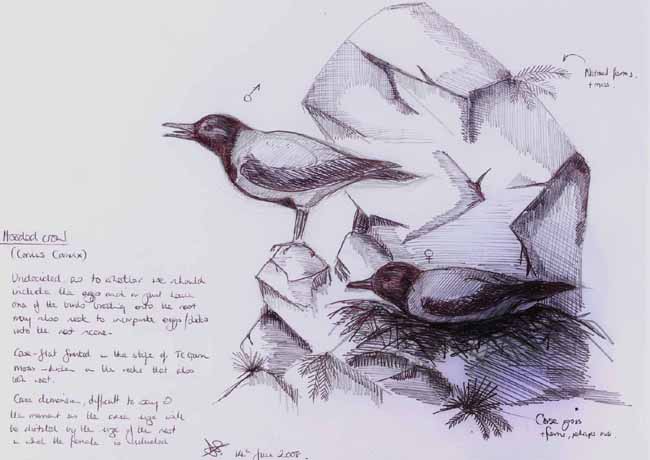
Pictoral view of a pending mordern case of Hooded Crows. Another collaborative effort, with a nest scene. Uncertain as to whether we should incorporate chicks and or eggs into this scene currently
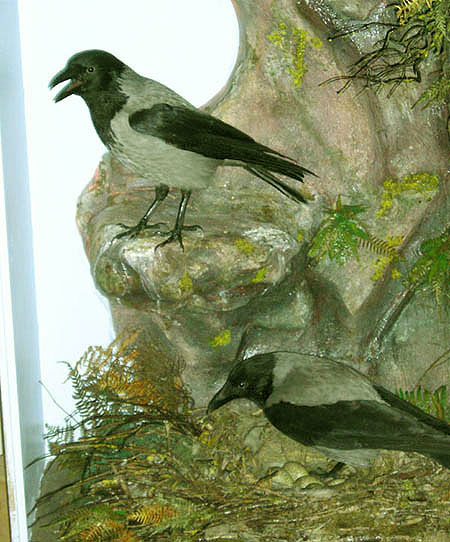
Hooded Crow case complete with eggs by Graham Axon.
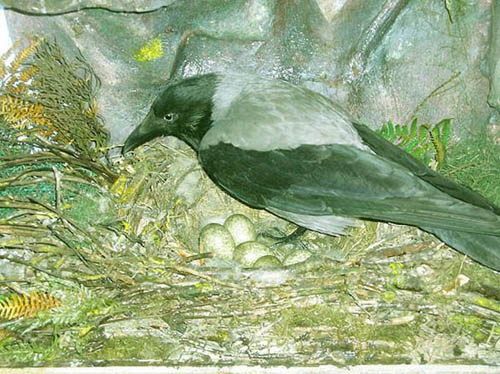
Hooded Crow case complete with eggs by Graham Axon, in close up.
The Hooded Crow case was constructed to demonstrate that a much maligned and persecuted genus can look wonderful in a cliff setting. That said it is testimony that the fact that these birds were shot in 2007 in County Antrim, located on the North East coast of Ireland, enabled this case to be constructed.
![dshocrow9 [640x480].jpg](dshocrow9 [640x480].jpg)
Hooded Crow. This case is just awaiting the 5 faux eggs and then perhaps some additional attention to the groundwork and it is complete. The aim was to complete an Irish mountain, so images were sought for the rock colour in County Antrim and this was the closest match.
The reproduction eggs by G Axon are superb as are any of the eggs that he creates. Each egg takes around 4-7 hours to create from start to finish. Again it was decided to utilise five eggs in the clutch as this is the normal brood amount for Corvids. The birds in the case are perhaps not a “true” pair is sexing this species is difficult as the sexes are identical, perhaps the only difference being that the hen bird may be slightly larger than the male. .
Recollection of Mr A.E.KNOX regarding Hooded Crows which are now absent from Sussex. .New Grove, Petworth, Sussex,
December, 1843.
The many well-authenticated instances which are on record of the hooded crow having paired with the carrion crow in a wild state, would refute such an idea.* Perhaps the different character and aspect of the country, in the immediate vicinity
of the coast, to the east, and to the west, may afford a clew to unravel the mystery.
To the eastward near Brighton, and for many miles in that direction, the naked downs approach the coast, the country is generally open, and presents a considerable extent resembling (at least in the absence of wood) the native haunts of the hooded crow in the north of Scotland and Denmark. A natural predilection in favour of such a country may therefore induce these birds to prefer the neighbourhood of this treeless tract to the wooded and highly cultivated district which extends to the very shore in the more western part of Sussex ; and admitting, for a moment, this conjecture to be correct, a similar course of reasoning would account for the partiality of the carrion crow for
the latter country. I should have observed that the carrion crow, even where it occurs
in the greatest numbers during the winter months, as at the mouth of Pagham harbour, and the inlets of the sea to the south of Chichester, seems always more or less to live in pairs, both when feeding and when on the wing, and never assembles in large flocks, as the hooded crow is well known to do in the immediate neighbourhood of Brighton, and even on the beach between the houses and the sea. The food of both these Corvidae at this season of the year consists of oysters, muscles, small crabs, marine insects, worms, and dead fish which are cast up by the waves during the prevalent south-westerly storms. At Pagham, in the vicinity of the oyster beds, the carrion crow has frequently been observed to ascend to a great height in the
air with one of these fish in his claws, and after letting it fall on the beach to descend rapidly with closed pinions, and devour the contents, which, but for the shock or fracture occasioned by the fall, he would have been unable to disengage from the shell. I do not know an instance of the hooded crow's having ever been observed to resort to a similar expedient. The hooded crows make their appearance about the beginning of October, haunting the upper parts of the tide rivers at Shoreham and *
Vide Yarrell's ' History of British Birds,' vol. ii. p 86 Newhaven, and the fields at some distance from the coast, gradually becoming more gregarious, and more marine in their habits as the winter approaches. Perhaps they never appear more numerous than at that period which immediately precedes their departure for the north. When at
Brighton about the end of last March I noticed as many as thirty assembled on the shore opposite Brunswick Terrace, and a much larger flock in a neighbouring field at Hove, and in a few days afterwards not a bird was to be seen. The carrion crows commence their return from the coast to the interior at a somewhat earlier period, and
as might be expected from their having sojourned in pairs during the winter, their departure is not so sudden and simultaneous, but they seem gradually to appear less numerous, until at last they entirely desert the shores for the woods and forests of the interior.
Reading the above it is likely, given that those agricultural practices have only slightly changed that the demise of the crow in this region is likely due to continued and systematic persecution by Game keepers and hunters. The Crows from The Booth Museum in Brighton were obtained from "Victorian Hooded Crows with chicks. Specimens shot / obtained from Lairg of Sutherland, June 1869". , perhaps indicating that this species was already absent from Sussex as with other Corvids in this collection, most were obtained locally by Booth himself such as Jackdaws, Rooks, Jays and Magpies.
Crows in cultural Mythology
Corvids were also connected with the Valkyries, as in "choughs of the Valkyries" . Whether chough means chough (Latin name pyrrhocorax pyrrhocorax), in this case, or is an artistic rendering of raven, it is difficult to say. Valkyries may have been reflections of the "shield-maids" or skjald-meyer of the Huns, and it is worth pointing out that some sources state that the Irish battle Goddesses were not represented by ravens, but by the crow , particularly the hooded crow, or "scald-crow" .
Many of the Celtic goddesses are linked with the raven or crow. In this mythology the goddesses are the aggressive deities, those associated with war and death. Badb, Macha and Nemain are all associated with crows and/or ravens, as is Nantosuelta, a Gaulish water and healing goddess. The wife of the Fomorian sea-god, Tethra, was said to be a crow goddess who also hovered above battlefields, and Scottish myth has the Cailleach Bheure, who often appeared in crow form . The association of the birds with death and war is an obvious reflection of its tendency to eat carrion, plenty of which is to be found in the aftermath of battle. This tendency led, eventually, to the persecution of the raven, as a harbinger of doom and destruction, and also to the common notion in modern European culture that the main attribute of Crow and Raven is their connection with the Otherworld. Upon Cuchulainn's death, the Morrigan perched on his shoulder in the form of a raven.
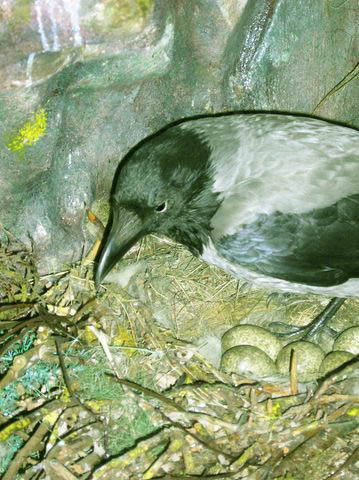
Hooded Crow case complete with eggs by Graham Axon, in close up.
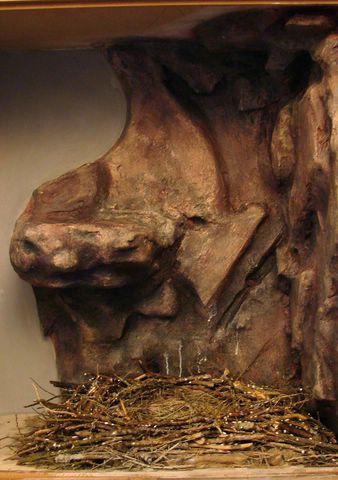
Hooded Crow. Groundwork without the birds, showing the colour of the rocks and nest.
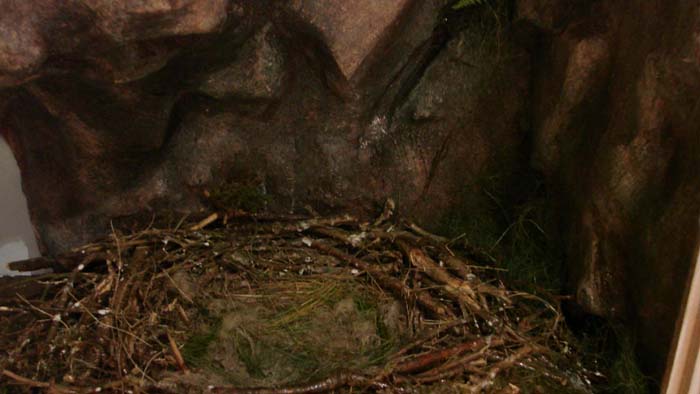
Hooded Crow. Groundwork without the birds, showing the colour of the rocks and nest.
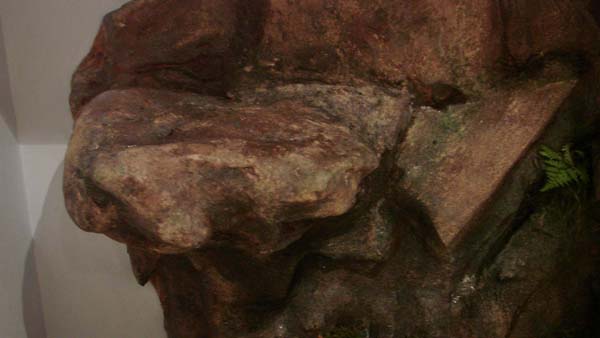
Hooded Crow. Groundwork without the birds, showing the colour of the rocks.
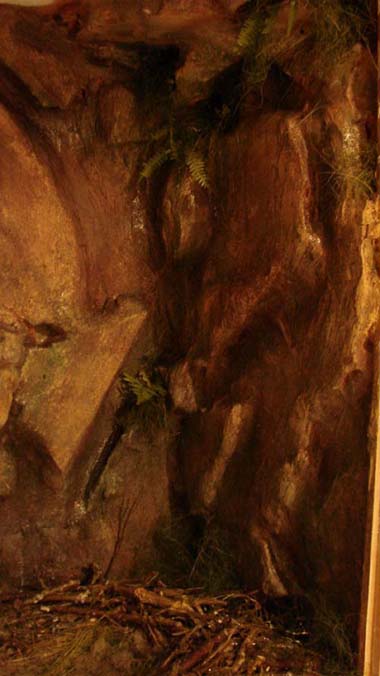
Hooded Crow. Groundwork without the birds, showing the colour of the rocks and nest.
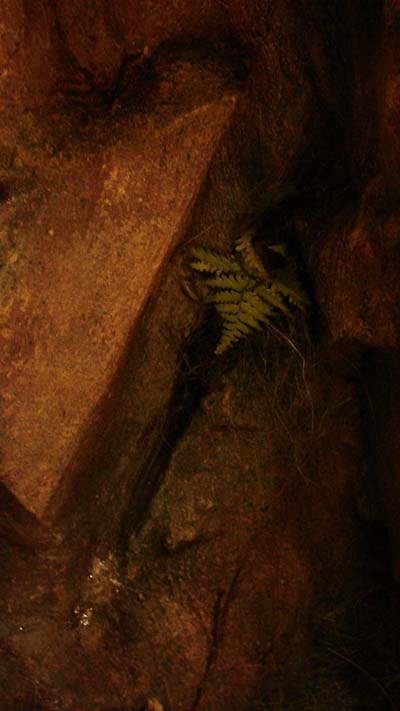
Hooded Crow. Groundwork without the birds, showing the colour of the rocks and nest.
The other main characteristic of Raven in Irish and Welsh myth is that of prophesy. The Morrigan was prone to prophesising, predicting the outcome of battle. King Cormac also came across the Badb as an old woman dressed in red garments (always a bad sign) who explained that she was washing the armour of a doomed king. Raven also acts as a messenger for the Irish/Welsh gods. Bran the Blessed (Bendigeidfran) is perhaps the best known of the Celtic gods associated with the raven, not least because of his association with the Tower of London, where ravens are still kept, wings clipped, in order to assure the safety of the realm. Bran's head, which he ordered to be cut off after being mortally wounded in the foot, is said to be buried in the White Tower. Badhbh is the Irish for a "scald crow" (Hooded Crow), but more interestingly it is the name of one of the Celtic war goddesses who would shriek over the battlefields in the form of a crow.
In "The Hawk of Achill" Cuchulainn's father, Lugh, is spoken of in association with ravens and crows. Ravens warned Lugh of the Formorians' approach. Ravens tended Cuchulainn when he was very ill, which is about the only time Cuchulainn appears to have had anything approaching a good relationship with the birds, save for when he was announced by two Druidic ravens on his entrance to Elysium . He was responsible for killing a flock of magical sea ravens, which were large and able to swim in the sea (it is possible, from the description, that the birds were, in fact, cormorants, and not ravens at all. Cormorants also have a certain mythology associated with them). Also associated with ravens is the son of Cerridwen, Afagddu, who was also known as Morvran, or Sea Raven. Cerridwen 's intent had been to bestow the gift of Inspiration upon him.
![dshocrow8 [640x480].jpg](dshocrow8 [640x480].jpg)
Hooded Crow.
A rather bizarre association is that of ravens and chess. In the Welsh "The Dream of Rhonabwy", Owain ap Urien and Arthur were playing a game which is thought to have been a chess equivalent. Three hundred ravens are mentioned in this tale as belonging to Owain, a gift from Cenferchyn. Arthur's men attacked the ravens during play, and eventually Owain told them to retaliate, upon which they attacked Arthur's men unmercifully. One of the pieces in chess is, of course, the rook, another member of the crow family (corvus frugilegus).
![dshocrow.7 [640x480].jpg](dshocrow.7 [640x480].jpg)
Hooded Crow. Hen bird about the "brood" the eggs. We have also included Sheep wool in the nest which is typical for this bird.
In Cervantes' "Don Quixote", the hero says that Arthur was not killed at all, but was turned into a raven. Arthur is also sometimes associated with the cult of Mithras, which was popular with the Roman legions. The cult organisation was based upon seven ranks that a worshipper could pass through, and the first of these was Raven. The raven, reprising his most common role in terms of masculine European mythology, was Ahura-Mazda's messenger and represented Mercury. Initiates are shown on frescoes and mosaics as holding a cup and the caduceus . Also along these lines, Lugus was a Gaulish god of intelligence, and a mighty warrior. A relief from Senlis shows Lugus with ravens and geese, and the ravens appear to be speaking to him. Both Lugus and Odin are also linked with the Roman Mercury, bringing us to the connection between ravens and the art of the healer.
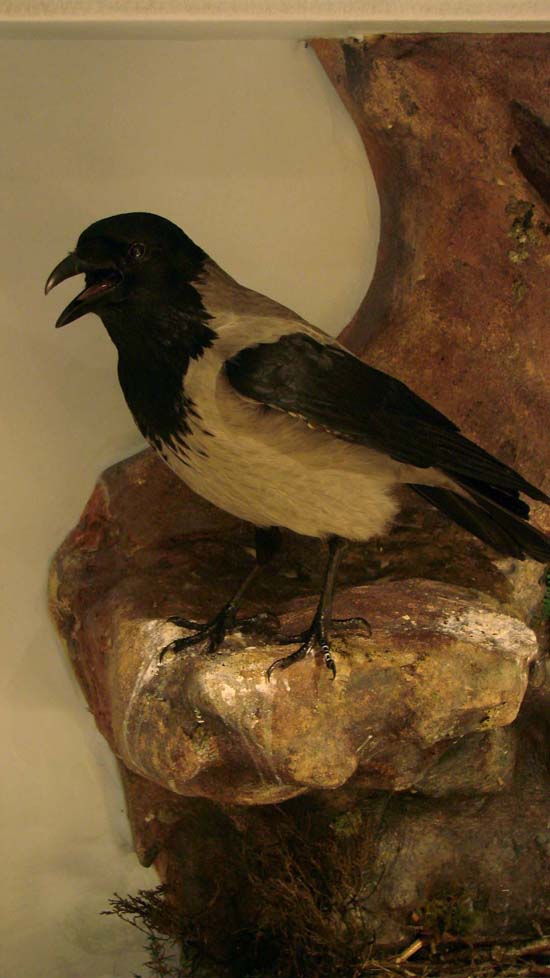
Hooded Crow.
In nearly all cultures, the raven or crow was originally white. In one of the Greek tales, Coronis, the daughter of Phlegyes was pregnant by Apollo. Apollo left a white crow (or raven) to watch over her, but, just before the birth, Coronis married Ischys. The crow informed Apollo of this, and Apollo was not impressed. He killed Coronis and Ischys, and turned the crow black for being the bearer of bad news. Luckily, Apollo retrieved the unborn child at the funeral, for the child became Aesclepius, the father of medicine.
It seems obvious, taking all these things into consideration, that the reputation of crow and raven for being dark messengers of doom, and concerned solely with death and destruction and the more black side of nature is ill-deserved. They do serve as couriers, it is true - an old Scots metaphor for death is talk of someone as having gone "awa' up the Crow Road" - but Raven has his wily beak into nearly everything, from the birth of medicine to the game of chess. The only thing you can be sure of with this character is that he is to be found at the extremities. In Haida mythology, it is even one of Raven's guises who determines the length of life of a new-born child. The constancy of Raven is his quest to fulfil an appetite - whether this be food, news, the sight of the slain on the battlefield, spirits of the dead for the Underworld, healing or prophecies of the future. The appetite is sometimes Raven's, sometimes that of the deity he signifies, but the appetite is always there. He is a creature of need, of want, of greed and gluttony, and can also demonstrate a possessive and jealous nature, but from that need and want, from the satisfaction of that appetite, great acts of creativity arise.
![dshocrow1 [640x480].jpg](dshocrow1 [640x480].jpg)
Hooded Crow.
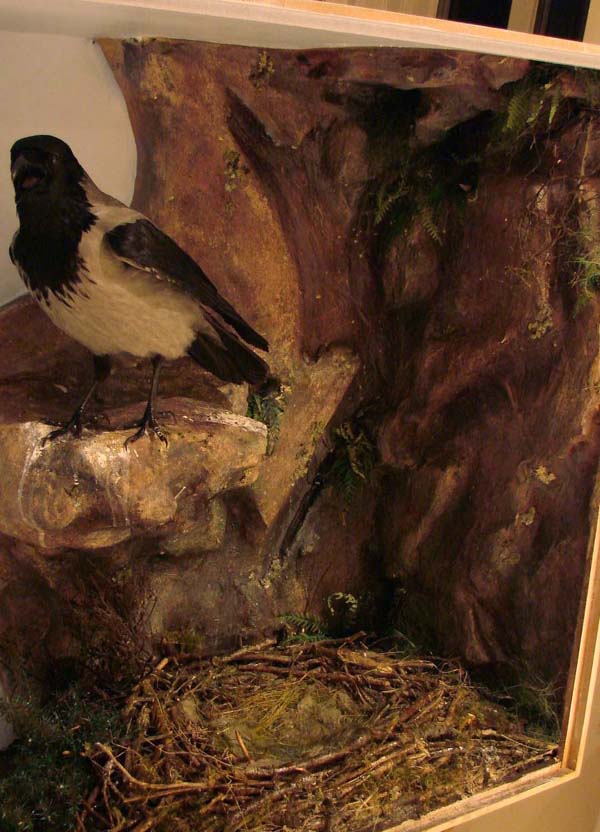
Hooded Crow.
In the British Isles, the Hooded Crow breeds regularly in Scotland, the Isle of Man, and in the Scottish Islands. It also breeds widely in Ireland. In autumn some migratory birds arrive on the east coast of Britain. In the past, this was a more common visitor, and in Hertfordshire was known as the Royston Crow after the town of Royston. The 150-year old local newspaper is still titled Royston Crow, and depicts the bird’s head on its masthead. The bird has by a long association with Royston dating back to 1648, gained the name of the Royston Crow. The stone on which the crow is perched is the Royston, a boulder which was originally at the base of the Roys Cross which stood for several centuries at the crossing of Ermine Street and the Icknield Way.
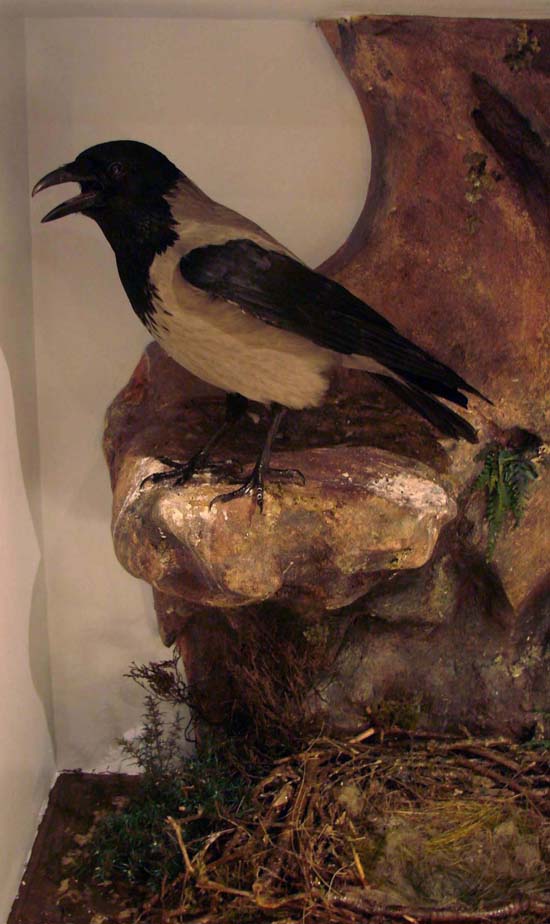
Hooded Crow.
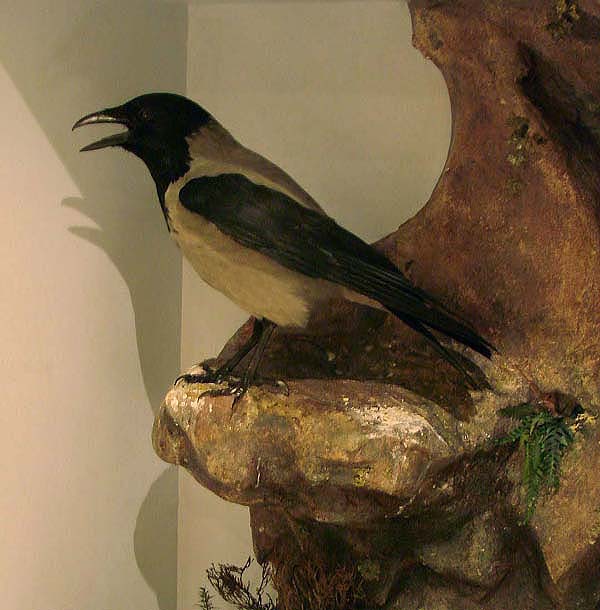
Hooded Crow.
This species, like its relative, is seen regularly killed by farmers and grouse estates. In County Cork, Ireland the county's gun clubs shot 23,000 Hooded Crows in two years in the early 1980s.The Hooded crow is featured on the crest of the North Hertfordshire District Council. On 17th September 2002, the British Ornithologists' Union decided that Hooded Crow was a species in its own right.
Taxidermy4Cash does not undertake taxidermy, rather we are collectors of
other people’s work, both current and historical we also offer web hosting,
a search engine submission service and increasingly one of the larger
article resource banks on the net. So if your keen to learn about Taxidermy
etc, then you know where to look.
We are always interested to here about new resource, if you feel a resource
should be listed here then please contact us.
|
ITEMS
WANTED. Please respond via this on-line form HERE
with a description of what you have for sale.
[HOMEPAGE]
Taxidermy Links.
Please double click on the Taxidermy link icon below.
Taxidermy
Links
|
|




![dshocrow9 [640x480].jpg](dshocrow9 [640x480].jpg)






![dshocrow8 [640x480].jpg](dshocrow8 [640x480].jpg)
![dshocrow.7 [640x480].jpg](dshocrow.7 [640x480].jpg)

![dshocrow1 [640x480].jpg](dshocrow1 [640x480].jpg)


